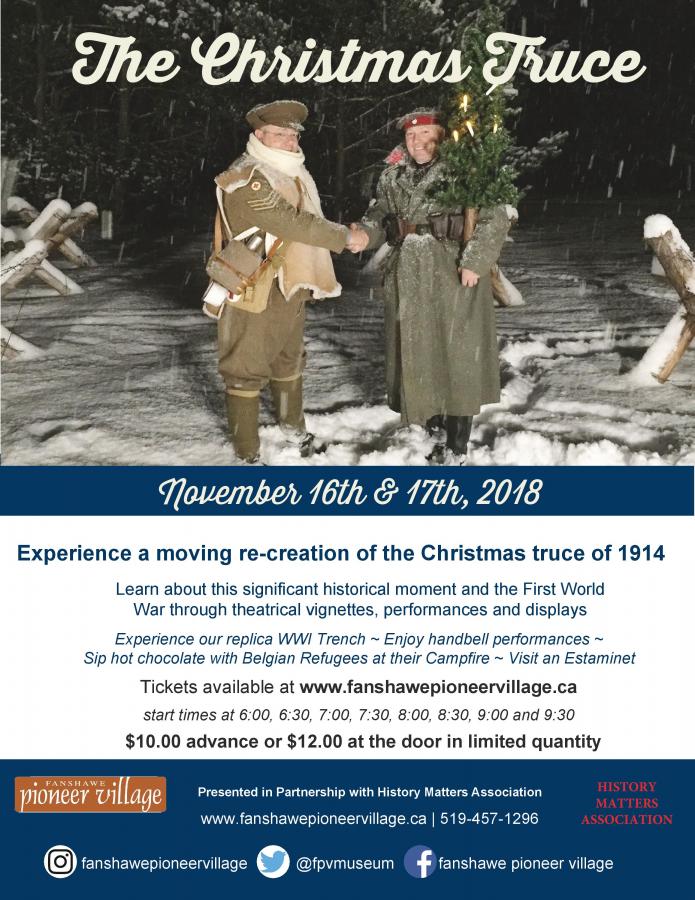In 1914, a brief, unofficial, truce took place at Christmas along parts of the Western Front. Soldiers from opposing sides came together to mark the season as strains of Silent Night echoed in the dark. Experience a WWI Christmas Story as you embark by foot on a journey through time to experience a significant moment in history at our replica trench. Enjoy choir and hand-bell performances, visit an Estaminet, a casualty clearing station, a homefront Christmas display, and more.
Performances, put on by experienced reenactors, run every 30 minutes from 6:00 p.m. through 9:30 p.m. and the event ends at 10:00 p.m. each night (it is recommended that those coming for the 9:30 p.m. show explore the village prior to their Christmas Truce reenactment). Tickets are $10 in advance and can be purchased at fanshawpioneervillage.ca; tickets are $12 at the door. Reservations recommended.
Presented in partnership with the History Matters Association.
We will be accepting non-perishable food donations at this event.
More Information on the Christmas Truce
The “Christmas Truce” (Weihnachtsfrieden or “Christmas Peace”) was a series of widespread but unofficial ceasefires along the Western Front around Christmas of 1914 between the British and French and German armies. This event only occurred during the first Christmas of the war, when hostilities were relatively recent, only 5 months into the 51 month struggle.
Hostilities had entered a lull along the Western Front during the onset of winter as both sides faced exhaustion, manpower and shell shortages and the front stabilized into a trench system, both sides digging in during the winter months to recoup losses and reconsider their strategies for the coming year as it was now clear the conflict would be a prolonged one with no hope of a breakthrough in the near future.
In this relative calm, both sides crossed trenches in the week leading up to Christmas, exchanging greetings. In some areas of the line, soldiers from both sides entered No Man’s Land on Christmas Eve and Christmas Day to exchange food, souvenirs and song. They agreed to joint burial ceremonies and prisoner exchanges. Football (soccer) games were arranged, which became one of the most memorable events of the Christmas Truce, along with Christmas carol-singing.
The Christmas Truce did not occur along the entire front. Fighting continued on some sectors and in others the Truce merely consisted of a ceasefire and/or an arrangement to recover bodies of dead soldier.
The Christmas Truce of 1914 caused great concern among the high commands of both sides, fearing it would lead to unwillingness to continue the fighting. The Christmas Truce was condemned and orders were issued that such ceasefires and mingling with the enemy was strictly prohibited.
These regulations, combined with an additional further year of violent conflict resulted in only a few units arranging ceasefires for the Christmas holidays of 1915. By 1916, due to the bitterness and high losses of life the war brought on all participants there was no further willing to have any dealings with the enemy and no similar truces of a similar magnitude were to occur for the duration of the war.
“Truces” or a “live and let live” attitude, which most often represented informal ceasefires along parts of the line or an agreement to collect bodies or wounded did occur sporadically throughout the conflict but the Christmas Truce was significant due to the number of men involved and the extent of the participation. Never had men openly congregated in No Man’s Land in the daylight and fraternized so easily with the enemy. The Christmas Truce is now viewed symbolically as a moment of peace and humanity in the middle of the most violent conflict the world had yet seen.

